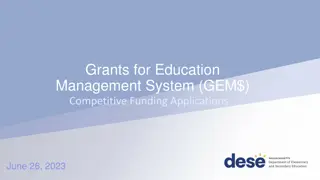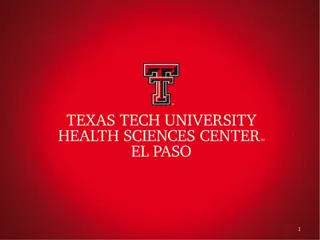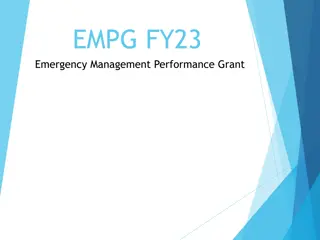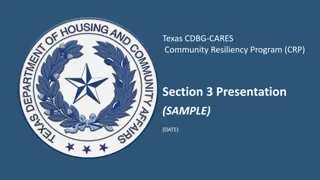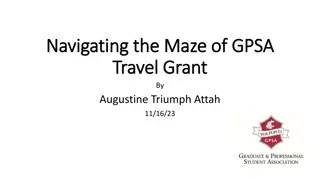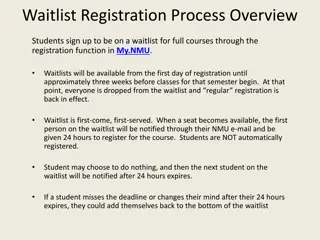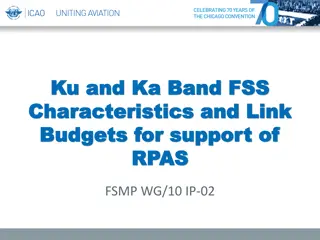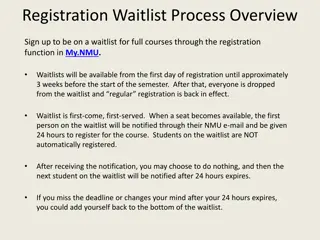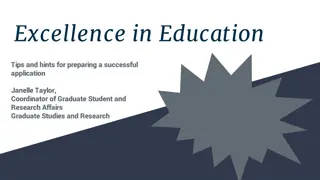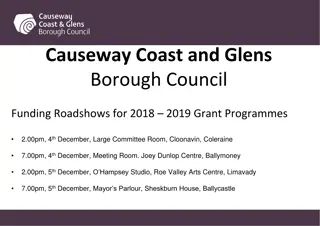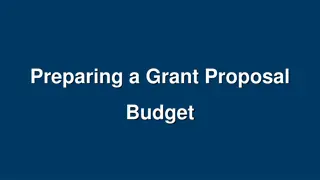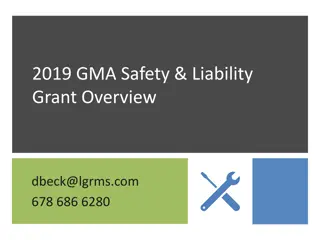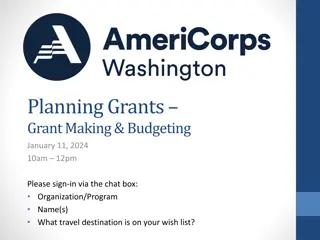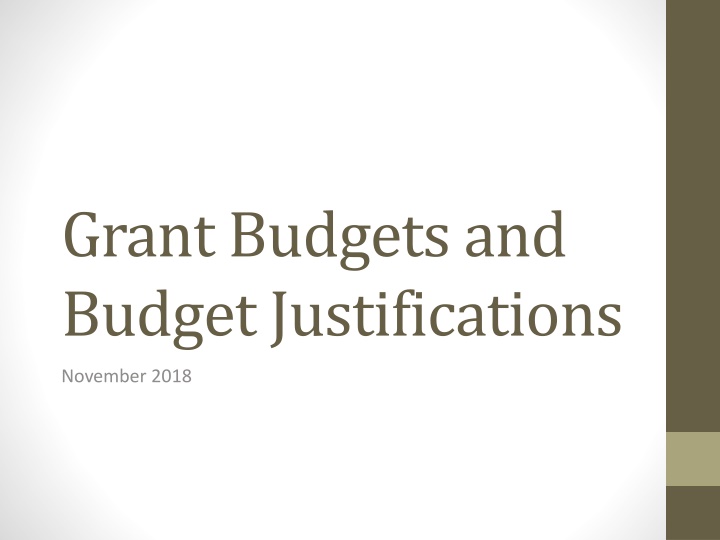
Financial Accountability and Compliance in Research Grants Management
Explore the vital aspects of financial accountability and compliance in managing research grants, including budget justifications, risks of non-compliance, institutional settlements, and best practices. Understand the importance of grant cost allowability, allocability, and reasonability to maintain public trust and avoid penalties. Learn about key guidelines such as the Uniform Guidance and the repercussions of non-compliance. Stay informed and ensure responsible stewardship of grant funds.
Download Presentation

Please find below an Image/Link to download the presentation.
The content on the website is provided AS IS for your information and personal use only. It may not be sold, licensed, or shared on other websites without obtaining consent from the author. If you encounter any issues during the download, it is possible that the publisher has removed the file from their server.
You are allowed to download the files provided on this website for personal or commercial use, subject to the condition that they are used lawfully. All files are the property of their respective owners.
The content on the website is provided AS IS for your information and personal use only. It may not be sold, licensed, or shared on other websites without obtaining consent from the author.
E N D
Presentation Transcript
Grant Budgets and Budget Justifications November 2018
Rules and Regulation GOVERNING POLICIES
Financial Accountability Preserve public / government trust in university Avoid mismanagement of federal funds Financial stewardship of a sponsor s resources Risk of non-financial compliance
Risks of Non-compliance Fines and penalties false claims act ($5,000 - $10,000 per false claim) Reduced research funding Enhances sponsor monitoring Designation as exceptional or high risk institution Compromise reputation Loss of public trust
Compliance Items Time and effort certification Cost transfers Direct charging clerical and administrative salaries Cost Sharing and Matching Timeliness of Report Submission
Uniform Guidance Federal Government s guidance on Administrative Requirements, Cost Principles, and Audit Requirement for Federal Awards Super Circular combines: A-21 Circular: determines costs applicable to grants, contracts, and other agreements with educational institutions A-110 Circular: sets forth standard for obtaining consistency and uniformity among Federal agencies in the administration of grant agreements with institutions of higher education. A-133 Circular: sets forth obtaining consistency and uniformity among Federal agencies for the audit of States, local government, and non-profit organizations expending Federal awards.
What happens if we dont? Recent Institutional Settlements 2016 $9.5M Columbia Inaccurate use of Indirect Cost Rate 2015 $19.8M U Florida Improper use of grant funds(2005-10) 2009 $7.6M Yale Effort Reporting 2006 $2.5M U Connecticut Service Center Billing Rates 2005 $4.4M Cornell Grant Money Paid to Non-Research Staff 2005 $6.5M Mayo Clinic Improper Cost Transfers 2005 $11.5M Florida International Improper Cost Transfers 2004 $2.4M Harvard Grants Billed for Unrelated Salaries 2004 $2.6M Johns Hopkins Faculty Effort Reporting 2003 $5.5M Northwestern Faculty Effort Reporting
Grant Cost Must Be Allowable Allocable Reasonable
Allowable Costs General Test of Allowability Costs Must Be: Treated consistently through generally accepted accounting principles Reasonable Allocable Conform to limitations of Uniform Guidance and agreement with terms and conditions
Allocable Costs A cost is allocable to a particular objective according to the relative benefits accrued to the objective. Any cost allocable to a particular award or other cost objective may not be shifted to other federal awards simply to overcome funding deficiencies nor to avoid restrictions imposed by law or by the terms of the award.
Reasonable Cost A cost is considered reasonable if the goods or services acquired, and the amount involved, reflect action that a prudent person would take under the circumstances.
Factors to Consider Is the cost necessary for the performance of the project? Was the cost budgeted in the proposal budget? What laws and regulations should be considered what are the terms and conditions of the award? Did all individuals act with prudence and satisfy their responsibilities to both the institution and the federal government?
Examples of Unallowable Costs Alcoholic beverages not part of an approved protocol Bad debts/directly associated legal costs First class air travel (usually) Product advertising Promotional items and social club memberships
Budget Principles Most funding agencies require that a proposed budget be based on a good faith estimate of the anticipated costs. A person may not knowingly include false, inaccurate or misleading cost information. What you put into the budget and justification turns into your commitment to the sponsor.
Essential Elements CONSTRUCTING A BUDGET
Direct Costs Expenditures needed to carry out the project Usually include: Salaries and benefits Travel expenses Supplies Contractual Services Equipment Tuition
Salaries and Wages Principal investigator or project director Coordinator, manager Research assistant Postdoctoral fellow Graduate assistant Technician Undergraduate student
Travel expenses ground transportation, airfare, lodging, meals conferences, meetings, fieldwork Supplies laboratory, photographic, animal care, educational/instructional Contractual outside lab analysis fees, rental fees, shipping, training, testing, honoraria (non-NMU employees)
Subawards portions of a budget for cost of project activities carried out by others at another institution or agency Equipment typically items over $5,000 (laboratory, office, medical, audio-visual)
F&A/Indirect Costs/Overhead Indirect costs are University operating expenditures incurred for common objectives which are not allocated to a specific project. Examples: Facilities (labs, offices, etc.), administrative services (purchasing, personnel, accounting, pre-award services, post- award project management, maintenance, utilities, dept. office expenses. NMU s rate: 34.5% of salaries, wages, fringe
Types of Cost Share Mandatory required condition of award Voluntary Committed offered, excess of mandatory, not a condition to be considered for the award
Possible Sources of Cost Share Employee time, including fringe benefits Graduate assistants, undergraduate students Equipment Volunteer time or other contributed items Unrecovered F&A Subrecipient cost-sharing Directly related supplies and services Travel
Adding it all up SAMPLE BUDGET
Project Expenses Principal Investigator Prof. Plum 20% time ($50,000 annual salary) 1 Graduate Research Assistant Travel 3 trips at $2,000 each Supplies: $8,800 Flowers for grant administer: $50 Tuition Subaward: $30,000
Provide a rationale JUSTIFICATION
Budget Justification Identifies your costs and explains the need for them. Answers any questions a reviewer may have about how you calculated your costs Indicates the base salaries and any yearly increases Should reflect the objectives of the project.
Tips Be sure everything in your budget is referenced in the proposal and everything in your proposal that would incur cost is explained in the justification. Follow the same order as the budget The more unusual the request, the more justification needed (personal computers)
Salaries and Wages Provide enough detail to make it clear why each person is necessary to the project and what the contribution will be: PI: P. Plum, PhD is Assistant Professor of __ in the __ department, with extensive experience in __. Dr. Plum will be responsible for __. Research Assistant: TBN, MS, will work with __ on __. In year one, this RA will __.
Description of Duties Weak: C. Mustard will analyze all data associated with the project. Strong: C. Mustard will be responsible for statistical analysis of data collected in experiments 1-3 which are directly tied to specific aims 3 and 4. He will also be responsible for day-to- day project planning, coordination with experts at partnering institutions, writing all progress reports, and supervising the RA.
Travel Provide information about: Purpose Duration Points of departure and destination Number of travelers Cost per traveler Registration fees, ground transport, etc.
Materials and Supplies Provide a list of the general types of expendable materials and supplies required You do not have to have an exhaustive list or show catalog numbers or other documentation Provide sufficient detail to show: You have anticipated the materials needed There is adequate justification for the amount requested.
Consultants Be sure that the daily rates is not in excess of the maximum allowed by the funding agency, provide justification of the rate If travel and subsistence costs are not factored into the daily rate, these should be justified separately
Subawards Justification for a subaward budget should come from the subaward partner(s) Include one or two sentences describing why the work cannot be done at NMU and why you chose the partner(s) you did
Tips Don t give them something to cut Don t try to give the agency a bargain Too many 000 s look like you guessed on costs It s not how much money you want, its how much the project costs Double-check what expenses the sponsor will not allow A budget is just plan, it can be renegotiated
Questions? Kristin Beck krbeck@nmu.edu



